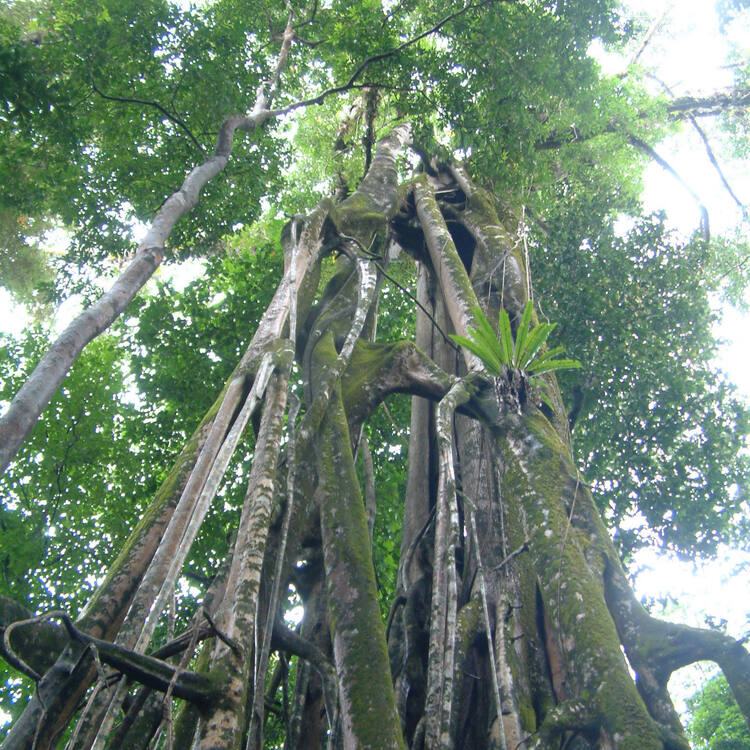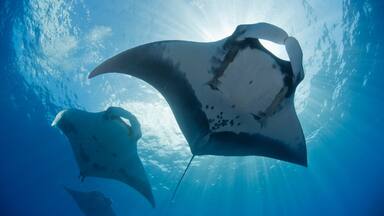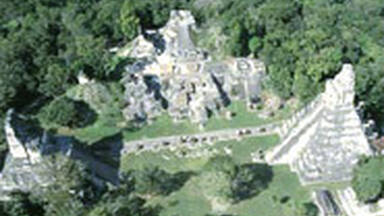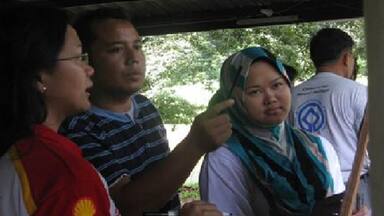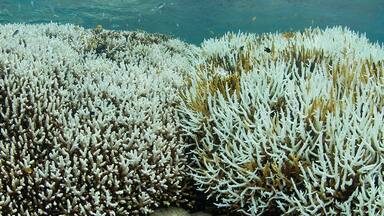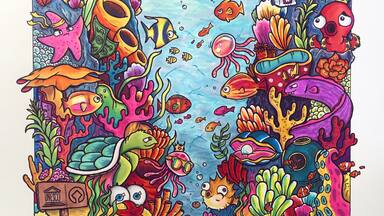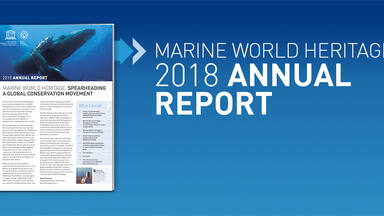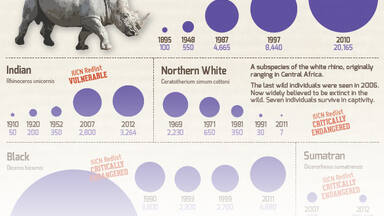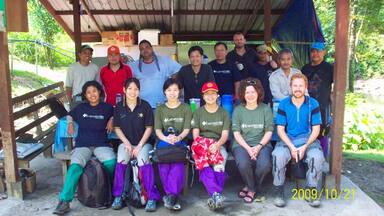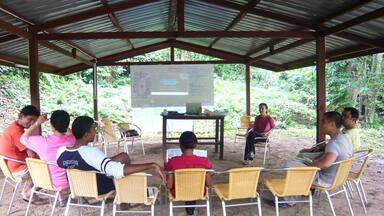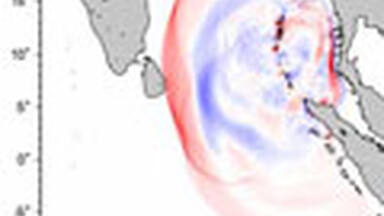Ujung Kulon National Park
Ujung Kulon National Park
This national park, located in the extreme south-western tip of Java on the Sunda shelf, includes the Ujung Kulon peninsula and several offshore islands and encompasses the natural reserve of Krakatoa. In addition to its natural beauty and geological interest – particularly for the study of inland volcanoes – it contains the largest remaining area of lowland rainforests in the Java plain. Several species of endangered plants and animals can be found there, the Javan rhinoceros being the most seriously under threat.
Description is available under license CC-BY-SA IGO 3.0
Parc national de Ujung Kulon
Le parc national, situé à l'extrémité sud-ouest de Java en bordure du détroit de la Sonde, englobe la péninsule d'Ujung Kulon et plusieurs îles, et il comprend la réserve naturelle du Krakatoa. Outre sa beauté naturelle et son intérêt géologique, notamment pour l'étude du volcanisme insulaire, il contient la plus grande superficie restante de forêts pluviales de plaine de Java. Il abrite plusieurs espèces végétales et animales menacées, dont la plus menacée de toutes, le rhinocéros de Java.
Description is available under license CC-BY-SA IGO 3.0
المنتزه الوطني في أوجونغ كولون
يضمّ المنتزه الوطني الذي يقع على طرف جافا الجنوبي الغربي على ضفاف مضيق "لاصوند" شبه جزيرة "أوجونغ كولون" وجزرًا كثيرة، ويشمل محمية "كراكاتوا" الطبيعية. وإلى جانب جمال طبيعته وأهميته الجيولوجية، لا سيما لدراسة حركة البراكين في الجزر، يشتمل المنتزه على المساحة الأكبر المتبقية من الغابات المطرية في سهل جافا. ويؤوي أجناسًا نباتية وحيوانية كثيرة معرضة للانقراض، وأكثرها تعرضًا على الإطلاق وحيد قرن جافا.
source: UNESCO/CPE
Description is available under license CC-BY-SA IGO 3.0
马戎格库龙国家公园
马戎格库龙国家公园位于巽他大陆架的爪哇岛最西南端,包括马戎格库龙半岛和几个近海岛屿,其中有喀拉喀托(Krakatoa)保护区。这里自然风光秀丽,在地质研究方面具有重要意义,特别是为内陆火山的研究提供了很好的例证。除此之外,这里还保留着爪哇平原上面积最大的低地雨林。在那里生存着几种濒危动植物,其中受到威胁最大的是爪哇犀牛。
source: UNESCO/CPE
Description is available under license CC-BY-SA IGO 3.0
Национальный парк Уджунг-Кулон и вулкан Кракатау
Национальный парк, расположенный на крайней юго-западной оконечности острова Ява в районе Зондского пролива. Он включает полуостров Уджунг-Кулон и несколько прибрежных островов, в т.ч. группу островов Кракатау. Местность выделяется особенной живописностью, представляет большой геологический интерес и дает возможность изучения островных вулканов. Здесь сосредоточены самые значительные массивы низкогорных влажно-тропических лесов из всех, уцелевших в равнинной части Явы. В парке имеют место представители нескольких исчезающих видов растений и животных. В т.ч. это находящийся под угрозой исчезновения яванский носорог.
source: UNESCO/CPE
Description is available under license CC-BY-SA IGO 3.0
Parque nacional de Ujung Kulon
Situado en el extremo sudoccidental de Java, a orillas del estrecho de la Sonda, este parque abarca la península de Ujung Kolon y varias islas, así como la reserva natural de Krakatoa. Además de su belleza natural e interés geológico para el estudio del vulcanismo insular, el parque cuenta con la zona más extensa de bosques lluviosos de tierras bajas que queda en Java. También alberga diversas especies vegetales y animales en peligro de extinción, en particular el rinoceronte de Java.
source: UNESCO/CPE
Description is available under license CC-BY-SA IGO 3.0
ウジュン・クロン国立公園
source: NFUAJ
Nationaal park Ujung Kulon
Source: unesco.nl
Outstanding Universal Value
Brief synthesis
Ujung Kulon National Park, located in Banten Province on the extreme south-west tip of the highly populated island of Java, has the best and most extensive lowland forest remaining on the island. The property, including the Ujung Kulon peninsula and several offshore islands retains its natural beauty and possesses a very diverse flora and fauna, demonstrating on-going evolution of geological processes since the Krakatau eruption in 1883. The Krakatau volcano as part of the formation of the property, is the most well known and studied of all modern volcanic eruptions, due primarily to the devastating effects (36,000 people killed) registered throughout the northern hemisphere. The property is globally significant as the last and most important natural habitat of the critically endangered, endemic, single-horned Javan Rhinoceros (Rhinoceros sondaicus) along with several other species of endangered plants and animals. Ujung Kulon is believed to sustain the last viable natural population of this species, estimated at approximately 60 individuals. It is not known how this compares to historical densities, but is a critically low figure from the point of view of species survival and viable genetic diversity.Other notable mammals in the property include carnivores, such as leopard, wild dog (dhole), leopard cat, fishing cat, Javan mongoose and several species of civets. It is also home to three endemic primate species; the Javan gibbon, Javan leaf monkey and silvered leaf monkey. Over 270 species of birds have been recorded and terrestrial reptiles and amphibians include two species of python, two crocodile species and numerous frogs and toads.
Criterion (vii) : Krakatau is one of natural world’s best-known examples of recent island volcanism and the property with its forests, coastline and islands is a natural lanscape of high scenic attaction. The physical feature of Krakatau Island combined with the surrounding sea, natural vegetation, succesion of vegetation and volcanic activities combine to form a lanscape of exceptional beauty. In addition, the combination of natural vegetation of the lowlands, tropical rainforests, grass lands, beach forests, mangrove forests and coral reefs within the property, are of exceptional magnificence. The property includes the Ujung Kulon peninsula and several offshore islands that demonstate on-going evolutionary processes, especially following the dramatic Krakatau eruption in 1883.
Criterion (x) : Containing the most extensive remaining stand of lowland rainforest on Java, a habitat that has virtually disappeared elsewhere on the island and is under severe pressure elsewhere in Indonesia and Southeast Asia, the peninsula of Ujung Kulon provides invaluable habitat critical for the survival of a number of threatened plant and animal species, most notably the endangered Javan Rhino (Rhinoceros sondaicus). The Javan rhino is not known to occur in the wild anywhere else on earth and Ujung Kulon is believed to sustain the last viable natural population, estimated at approximately 60 individuals. Efforts to protect the Javan rhino’s remaining habitat and individuals have become a symbol for protection of rainforest of worldwide significance, adding to the international importance of the management and preservation of the Ujung Kulon ecosystem.The property also provides a valuable refuge for 29 other species of mammals; nine of which are on the IUCN red list with three species considered endangered and including leopard (Panthera pardus), the endemic Javan gibbon (Mylobates moloch) and Javan leaf monkey (Presbytis comata). Avifauna recorded within the property includes 270 species while two species of crocodile, the endangered false gharial (Tomistoma schlegelii) and the vulnerable estuarine crocodile (Crocodylus porosus) are included in the reptile and amphibian species recorded for the property. In addition to the rich fauna 57 species of rare plants have also been recorded.
Integrity
The oldest and largest of the protected areas on the island of Java the boundary of the property encloses a very large area that is sufficient to protect its outstanding scenic, natural values as well as the important biodiversity values that warranted inscription on the World Heritage List. The huge volcanic mass of Krakatau dominates the property and is completely contained within its boundaries.
The property contains all the necessary habitat for the in-situ conservation of its unique biological diversity, including those habitats required to support the threatened species and other biota of outstanding universal value. While it is no longer possible to increase the size of the property, its location, in particular on the peninsula, provides managers with an ideal geographic unit for management.
A number of the component areas of the property are surrounded by buffer zones with activities in the zone given increasing attention in regards to regulation from the relevant provincial authority, with advice from the management agency. Poaching of the Javan Rhino has always been the main management issue and careful monitoring is required to ensure there is no illegal poaching of this critically endagered species as well as the other unique biodiversity contained and protected within the property.
Protection and management requirements
The property is managed by the central goverment through the technical implementation unit of the Directorate General of Forest Protection and Nature Conservation, of the Ministry of Forestry. The peninsula, along with Pulau Panaitan were established as a nature reserve in 1921 and subsequently redesignated as a game reserve and extended in 1958 to include several offshore islands and marine areas. The mainland component of the property was established as a nature reserve in 1967 and the Ujung Kulon reserve complex was declared a ‘proposed’ national park in 1980 with the Krakatau Nature Reserve included into the site in 1983.
The long history of conservation action in the property, dating back to 1921, has helped to protect the values contained within the boundaries despite the lack of a solid legal basis during the early establishment of the reserves. The long term management plan of Ujung Kulon National Park (2001-2020) is the basis for maintaining its natural beauty and preserving the critical habitats. Implementation of the management plan has helped to control the problems of illegal encroachment, logging, and commercial fishing within the boundaries of the property. The buffer zone on the land boundary effectively strengthens protection of the property and in addition, the involvement of various stakeholders from the local, national and international community has enhanced the protection of its values and integrity.
Generally well preserved, encroachment pressures are primarily confined to the eastern boundary on the mainland. Management prioritises long-term survival of the Javan Rhinoceros along with the other endangered species recorded within the property. The Strategy and Action Plan for the Conservation of Rhinos in Indonesia (2007-2017) developed with broad, open, and transparent participatory processes has greatly assisted the future survival of this critically endangered animal. The strategy addresses threats from inbreeding, global warming, and human pressure and includes the development of a new sanctuary within the property and a site outside the property as additional habitat for rhino populations.
Poaching of the Javan rhino has historically been the main management issue within the property. Strengthening of protection through management actions has allowed the population to grow with the highest priority of conservation efforts being the in situ preservation of the population, allowing numbers to increase. Increasing pressure from agricultural encroachment, illegal logging and firewood collection in the terrestrial areas and illegal commercial fishing within the marine components of the park continue to pose a threat to the values of the property. Along with impacts from tourism these issues all require monitoring and enforcement of regulations to ensure long-term conservation of the property.
